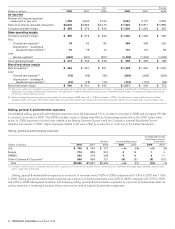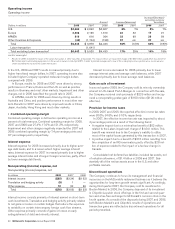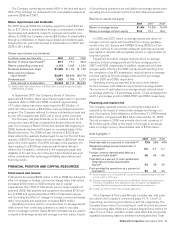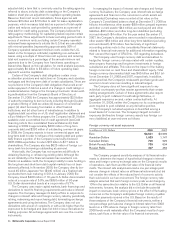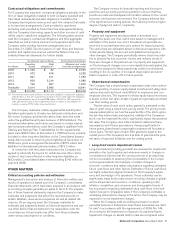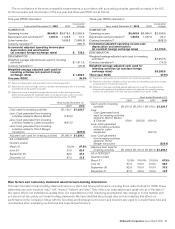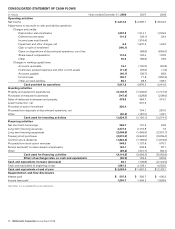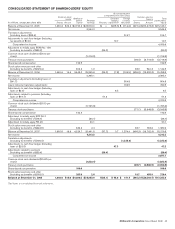McDonalds 2008 Annual Report Download - page 38
Download and view the complete annual report
Please find page 38 of the 2008 McDonalds annual report below. You can navigate through the pages in the report by either clicking on the pages listed below, or by using the keyword search tool below to find specific information within the annual report.
adjusted debt, a term that is commonly used by the rating agencies
referred to above, includes debt outstanding on the Company’s
balance sheet plus an adjustment to capitalize operating leases.
Based on their most recent calculations, these agencies add
between $6 billion and $12 billion to debt for lease capitalization
purposes, which increases total debt as a percent of total capital-
ization and reduces cash provided by operations as a percent of
total debt for credit rating purposes. The Company believes the
rating agency methodology for capitalizing leases requires certain
adjustments. These adjustments include: excluding percent rents in
excess of minimum rents; excluding certain Company-operated
restaurant lease agreements outside the U.S. that are cancelable
with minimal penalties (representing approximately 30% of
Company-operated restaurant minimum rents outside the U.S.,
based on the Company’s estimate); capitalizing non-restaurant
leases using a multiple of three times rent expense; and reducing
total rent expense by a percentage of the annual minimum rent
payments due to the Company from franchisees operating on
leased sites. Based on this calculation, for credit analysis purposes,
approximately $4 billion to $5 billion of future operating lease
payments would be capitalized.
Certain of the Company’s debt obligations contain cross-
acceleration provisions and restrictions on Company and subsidiary
mortgages and the long-term debt of certain subsidiaries. There are
no provisions in the Company’s debt obligations that would accel-
erate repayment of debt as a result of a change in credit ratings or
a material adverse change in the Company’s business. Under exist-
ing authorization from the Company’s Board of Directors, at
December 31, 2008, the Company has approximately $2.3 billion
of authority remaining to borrow funds, including through (i) public
or private offering of debt securities; (ii) issuance of commercial
paper; (iii) direct borrowing from banks or other financial
institutions; and (iv) other forms of indebtedness. In addition to
registered debt securities on a U.S. shelf registration statement and
a Euro Medium-Term Notes program, the Company has $1.3 billion
available under a committed line of credit agreement (see Debt
financing note to the consolidated financial statements). Debt
maturing in 2009 is approximately $400 million of long-term
corporate debt and $230 million of outstanding commercial paper.
In 2009, the Company expects to issue commercial paper and
long-term debt in order to refinance this maturing debt and poten-
tially finance a portion of the Company’s previously disclosed
2007-2009 expectation to return $15 billion to $17 billion to
shareholders. The Company also has $625 million of foreign cur-
rency bank line borrowings outstanding at year-end.
Historically, the Company has not experienced difficulty in
obtaining financing or refinancing existing debt. Although the
recent instability in the financial markets has resulted in con-
straints on available credit, the Company’s ability to raise funding in
the long-term and short-term debt capital markets has not been
adversely affected. In November 2008, the Company directly bor-
rowed 40 billion Japanese Yen ($440 million) via a floating-rate
syndicated term loan maturing in 2014. In January 2009, the
Company issued $400 million of 10-year U.S. Dollar-denominated
notes at a coupon rate of 5.0%, and $350 million of 30-year
U.S. Dollar-denominated bonds at a coupon rate of 5.7%.
The Company uses major capital markets, bank financings and
derivatives to meet its financing requirements and reduce interest
expense. The Company manages its debt portfolio in response to
changes in interest rates and foreign currency rates by periodically
retiring, redeeming and repurchasing debt, terminating exchange
agreements and using derivatives. The Company does not use
derivatives with a level of complexity or with a risk higher than the
exposures to be hedged and does not hold or issue derivatives for
trading purposes. All exchange agreements are over-the-counter
instruments.
In managing the impact of interest rate changes and foreign
currency fluctuations, the Company uses interest rate exchange
agreements and finances in the currencies in which assets are
denominated. Derivatives were recorded at fair value on the
Company’s Consolidated balance sheet at December 31, 2008 as
follows: miscellaneous other assets–$88 million; prepaid expenses
and other current assets–$44 million; accrued payroll and other
liabilities–$22 million; and other long-term liabilities (excluding
accrued interest)–$4 million. For the year ended December 31,
2007, the Company’s derivatives were recorded in miscellaneous
other assets–$64 million and other long-term liabilities (excluding
accrued interest)–$70 million. See Summary of significant
accounting policies note to the consolidated financial statements
related to financial instruments for additional information regarding
their use and the impact of SFAS No. 133 regarding derivatives.
The Company uses foreign currency debt and derivatives to
hedge the foreign currency risk associated with certain royalties,
intercompany financings and long-term investments in foreign
subsidiaries and affiliates. This reduces the impact of fluctuating
foreign currencies on cash flows and shareholders’ equity. Total
foreign currency-denominated debt was $4.5 billion and $6.1 bil-
lion at December 31, 2008 and 2007, respectively. In addition,
where practical, the Company’s restaurants purchase goods and
services in local currencies resulting in natural hedges.
The Company does not have significant exposure to any
individual counterparty and has master agreements that contain
netting arrangements. Certain of these agreements also require
each party to post collateral if credit ratings fall below, or
aggregate exposures exceed, certain contractual limits. At
December 31, 2008, neither the Company nor its counterparties
were required to post collateral on any derivative position.
The Company’s net asset exposure is diversified among a
broad basket of currencies. The Company’s largest net asset
exposures (defined as foreign currency assets less foreign cur-
rency liabilities) at year end were as follows:
Foreign currency net asset exposures
In millions of U.S. Dollars 2008 2007
Euro $4,551 $3,999
Australian Dollars 1,023 1,147
Canadian Dollars 795 929
British Pounds Sterling 785 634
Russian Ruble 407 463
The Company prepared sensitivity analyses of its financial instru-
ments to determine the impact of hypothetical changes in interest
rates and foreign currency exchange rates on the Company’s results
of operations, cash flows and the fair value of its financial instru-
ments. The interest rate analysis assumed a one percentage point
adverse change in interest rates on all financial instruments but did
not consider the effects of the reduced level of economic activity
that could exist in such an environment. The foreign currency rate
analysis assumed that each foreign currency rate would change by
10% in the same direction relative to the U.S. Dollar on all financial
instruments; however, the analysis did not include the potential
impact on revenues, local currency prices or the effect of fluctuating
currencies on the Company’s anticipated foreign currency royalties
and other payments received in the U.S. Based on the results of
these analyses of the Company’s financial instruments, neither a
one percentage point adverse change in interest rates from 2008
levels nor a 10% adverse change in foreign currency rates from
2008 levels would materially affect the Company’s results of oper-
ations, cash flows or the fair value of its financial instruments.
36 McDonald’s Corporation Annual Report 2008






